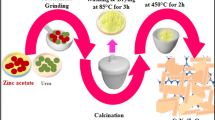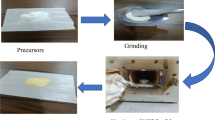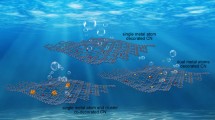Abstract
ZnO is an excellent semiconductor material for photocatalytic application. To overcome the photocorrosion of ZnO and improve its stability, nanorods (NRs) structured ZnO is prepared by an environment-friendly solid state synthesis method, and the composite of ZnO with different mass ratio of reduced graphene oxide (RGO) are obtained via a hydrothermal reaction. According to the photocatalytic results, 5% RGO composited with ZnO NRs degrades the methylene orange solution completely (98%) in 50 min under UV light irradiation, whereas bare ZnO NRs just degrade 40.9%. The transient photocurrent responses and electronical impedance spectroscopy tests are carried out to illustrate the mechanism of RGO in the nanocomposite for the enhancement of the photocatalytic performance. This composite of ZnO/RGO has demonstrated a great potential for high efficient and stable photocatalytic application.







Similar content being viewed by others
References
U.I. Gaya, A.H. Abdullah, Heterogeneous photocatalytic degradation of organic contaminants over titanium dioxide: a review of fundamentals, progress and problems. J. Photochem. Photobiol. C 9, 1–12 (2008)
L. Zhang, Y. Li, Q. Zhang, H. Wang, Hierarchical nanostructure of WO3 nanorods on TiO2 nanofibers and the enhanced visible light photocatalytic activity for degradation of organic pollutants. CrystEngComm 15, 5986–5993 (2013)
Y. Wang, D. Wang, B. Yan, Y. Chen, C. Song, Fabrication of diverse CuO nanostructures via hydrothermal method and their photocatalytic properties. J. Mater. Sci.: Mater. Electron. 27, 6918–6924 (2016)
Y. Wang, T. Jiang, D. Meng, J. Yang, Y. Li, Q. Ma, J. Han, Fabrication of nanostructured CuO films by electrodeposition and their photocatalytic properties. Appl. Surf. Sci. 317, 414–421 (2014)
Y. Yang, W. Que, X. Zhang, Y. Xing, X. Yin, Y. Du, Facile synthesis of ZnO/CuInS2 nanorod arrays for photocatalytic pollutants degradation. J. Hazard. Mater. 317, 430–439 (2016)
L. Zhang, W. Yu, C. Han, J. Guo, Q. Zhang, H. Xie, Q. Shao, Z. Sun, Z. Guo, Large scaled synthesis of heterostructured electrospun TiO2/SnO2 nanofibers with an enhanced photocatalytic activity. J. Electrochem. Soc. 164, H651–H656 (2017)
J. Liu, S. Yang, W. Wu, Q. Tian, S. Cui, Z. Dai, F. Ren, X. Xiao, C. Jiang, 3D Flowerlike α-Fe2O3@TiO2 core–shell nanostructures: general synthesis and enhanced photocatalytic performance. ACS Sustain. Chem. Eng. 3, 2975–2984 (2015)
S. Rajendran, M.M. Khan, F. Gracia, J. Qin, V.K. Gupta, S. Arumainathan, Ce3+-ion-induced visible-light photocatalytic degradation and electrochemical activity of ZnO/CeO2 nanocomposite. Sci. Rep. 6, 31641 (2016)
J. Jiang, H. Wang, X. Chen, S. Li, T. Xie, D. Wang, Y. Lin, Enhanced photocatalytic degradation of phenol and photogenerated charges transfer property over BiOI-loaded ZnO composites. J. Colloid Interface Sci. 494, 130–138 (2017)
L. Wang, S. Liu, Z. Wang, Y. Zhou, Y. Qin, Z.L. Wang, Piezotronic effect enhanced photocatalysis in strained anisotropic ZnO/TiO2 nanoplatelets via thermal stress. ACS Nano 10, 2636–2643 (2016)
P. Cheng, Y. Wang, L. Xu, P. Sun, Z. Su, F. Jin, F. Liu, Y. Sun, G. Lu, High specific surface area urchin-like hierarchical ZnO-TiO 2 architectures: hydrothermal synthesis and photocatalytic properties. Mater. Lett. 175, 52–55 (2016)
T. Xu, S. Venkatesan, D. Galipeau, Q. Qiao, Study of polymer/ZnO nanostructure interfaces by Kelvin probe force microscopy. Sol. Energy Mater. Sol. Cells 108, 246–251 (2013)
Y. Xia, J. Wang, J.-L. Xu, X. Li, D. Xie, L. Xiang, S. Komarneni, Confined formation of ultrathin ZnO nanorods/reduced graphene oxide mesoporous nanocomposites for high-performance room-temperature NO2 sensors, ACS Appl. Mater. Interfaces, 8, 35454–35463 (2016)
G. Katwal, M. Paulose, I.A. Rusakova, J.E. Martinez, O.K. Varghese, Rapid growth of zinc oxide nanotube–nanowire hybrid architectures and their use in breast cancer-related volatile organics detection. Nano Lett. 16, 3014–3021 (2016)
M. Drobek, J.-H. Kim, M. Bechelany, C. Vallicari, A. Julbe, S.S. Kim, MOF-based membrane encapsulated ZnO nanowires for enhanced gas sensor selectivity. ACS Appl. Mater. Interfaces 8, 8323–8328 (2016)
A. Barhoum, J. Melcher, G. Van Assche, H. Rahier, M. Bechelany, M. Fleisch, D. Bahnemann, Synthesis, growth mechanism, and photocatalytic activity of zinc oxide nanostructures: porous microparticles versus nonporous nanoparticles. J. Mater. Sci. 52, 2746–2762 (2017)
C. Wang, X. Tan, J. Yan, B. Chai, J. Li, S. Chen, Electrospinning direct synthesis of magnetic ZnFe2O4/ZnO multi-porous nanotubes with enhanced photocatalytic activity. Appl. Surf. Sci. 396, 780–790 (2017)
T. Kuila, A.K. Mishra, P. Khanra, N.H. Kim, J.H. Lee, Recent advances in the efficient reduction of graphene oxide and its application as energy storage electrode materials. Nanoscale 5, 52–71 (2013)
Y. Zhu, J. Xue, T. Xu, G. He, H. Chen, Enhanced photocatalytic activity of magnetic core–shell Fe3O4@ Bi2O3–RGO heterojunctions for quinolone antibiotics degradation under visible light. J. Mater. Sci.: Mater. Electron. 28, 1–10 (2017)
C. Cheng, R. Fan, Z. Wang, Q. Shao, X. Guo, P. Xie, Y. Yin, Y. Zhang, L. An, Y. Lei, J.E. Ryu, A. Shankar, Z. Guo, Tunable and weakly negative permittivity in carbon/silicon nitride composites with different carbonizing temperatures. Carbon 125, 103–112 (2017)
K. Zhang, G.-H. Li, L.-M. Feng, N. Wang, J. Guo, K. Sun, K.-X. Yu, J.-B. Zeng, T. Li, Z. Guo, M. Wang, Ultralow percolation threshold and enhanced electromagnetic interference shielding in poly(l-lactide)/multi-walled carbon nanotube nanocomposites with electrically conductive segregated networks. J. Mater. Chem. C 5, 9359–9369 (2017)
X. Bai, L. Wang, R. Zong, Y. Lv, Y. Sun, Y. Zhu, Performance enhancement of ZnO photocatalyst via synergic effect of surface oxygen defect and graphene hybridization. Langmuir 29, 3097–3105 (2013)
A.L. Palma, L. Cinà, S. Pescetelli, A. Agresti, M. Raggio, R. Paolesse, F. Bonaccorso, A. Di Carlo, Reduced graphene oxide as efficient and stable hole transporting material in mesoscopic perovskite solar cells. Nano Energy 22, 349–360 (2016)
T. Liu, K. Yu, L. Gao, H. Chen, N. Wang, L. Hao, T. Li, H. He, Z. Guo, A graphene quantum dot decorated SrRuO3 mesoporous film as an efficient counter electrode for high-performance dye-sensitized solar cells. J. Mater. Chem. A 5, 17848–17855 (2017)
H. Jin, Q. Chen, Z. Chen, Y. Hu, J. Zhang, Multi-LeapMotion sensor based demonstration for robotic refine tabletop object manipulation task. CAAI Trans. Intell. Technol. 1, 104–113 (2016)
Y. Shi, K. Wang, Y. Du, H. Zhang, J. Gu, C. Zhu, L. Wang, W. Guo, A. Hagfeldt, N. Wang, Solid-state synthesis of ZnO nanostructures for quasi-solid dye-sensitized solar cells with high efficiencies up to 6.46%. Adv. Mater. 25, 4413–4419 (2013)
T. Xu, J. Hu, Y. Yang, W. Que, X. Yin, H. Wu, L. Chen, Ternary system of ZnO nanorods/reduced graphene oxide/CuInS2 quantum dots for enhanced photocatalytic performance. J. Alloys Compd. 734, 196–203 (2018)
Z. Chen, N. Zhang, Y.-J. Xu, Synthesis of graphene–ZnO nanorod nanocomposites with improved photoactivity and anti-photocorrosion. CrystEngComm 15, 3022–3030 (2013)
C. Han, M.-Q. Yang, B. Weng, Y.-J. Xu, Improving the photocatalytic activity and anti-photocorrosion of semiconductor ZnO by coupling with versatile carbon. Phys. Chem. Chem. Phys. 16, 16891–16903 (2014)
S. Ma, J. Xue, Y. Zhou, Z. Zhang, Photochemical synthesis of ZnO/Ag2O heterostructures with enhanced ultraviolet and visible photocatalytic activity. J. Mater. Chem. A 2, 7272–7280 (2014)
L. Wu, F. Li, Y. Xu, J.W. Zhang, D. Zhang, G. Li, H. Li, Plasmon-induced photoelectrocatalytic activity of Au nanoparticles enhanced TiO2 nanotube arrays electrodes for environmental remediation. Appl. Catal. B 164, 217–224 (2015)
J. Yu, J. Jin, B. Cheng, M. Jaroniec, A noble metal-free reduced graphene oxide–CdS nanorod composite for the enhanced visible-light photocatalytic reduction of CO2 to solar fuel. J. Mater. Chem. A 2, 3407–3416 (2014)
Z. Li, F. Gao, N.C. Greenham, C.R. Mcneill, Comparison of the operation of polymer/fullerene, polymer/polymer, and polymer/nanocrystal solar cells: a transient photocurrent and photovoltage study. Adv. Funct. Mater. 21, 1419–1431 (2011)
T. Xu, L. Zhang, H. Cheng, Y. Zhu, Significantly enhanced photocatalytic performance of ZnO via graphene hybridization and the mechanism study. Appl. Catal. B 101, 382–387 (2011)
X. Men, H. Chen, K. Chang, X. Fang, C. Wu, W. Qin, S. Yin, Three-dimensional free-standing ZnO/graphene composite foam for photocurrent generation and photocatalytic activity. Appl. Catal. B 187, 367–374 (2016)
Y.C. Chen, K.I. Katsumata, Y.H. Chiu, K. Okada, N. Matsushita, Y.J. Hsu, ZnO–graphene composites as practical photocatalysts for gaseous acetaldehyde degradation and electrolytic water oxidation. Appl. Catal. A 490, 1–9 (2015)
Acknowledgements
The authors sincerely thank the financial supports from the National Natural Science Foundation of China (51502246), the Seed Foundation of Innovation and Creation for Graduate Students at Northwestern Polytechnical University (NPU) (Z2017193) and Undergraduate Student Innovation Training Program of NPU (201710699284).
Author information
Authors and Affiliations
Corresponding authors
Electronic supplementary material
Below is the link to the electronic supplementary material.
Rights and permissions
About this article
Cite this article
Xu, T., Hu, J., Yang, Y. et al. Solid-state synthesis of ZnO nanorods coupled with reduced graphene oxide for photocatalytic application. J Mater Sci: Mater Electron 29, 4888–4894 (2018). https://doi.org/10.1007/s10854-017-8447-4
Received:
Accepted:
Published:
Issue Date:
DOI: https://doi.org/10.1007/s10854-017-8447-4




